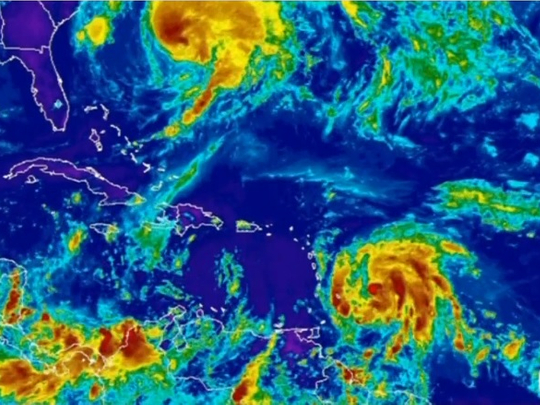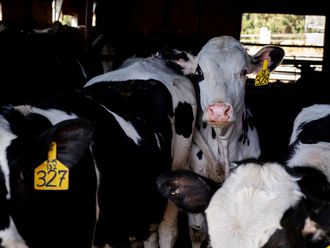
SAN JUAN, Puerto Rico: Hurricane Maria strengthened into a Category 3 storm on Monday and pushed toward the Leeward Islands in the eastern Caribbean and was expected to become a major hurricane by early Tuesday.
Hurricane Jose, meanwhile, is threatening the US north-east along the Atlantic coast.
Both storms are seen to deteriorate rapidly through Wednesday.
Maria
Maria was on a path that would take it near many of the islands already wrecked by Hurricane Irma and then on toward Puerto Rico, the Dominican Republic and Haiti.
#UPDATE Hurricane Maria bears down on battered Caribbean https://t.co/oEbncQeTBN pic.twitter.com/KdGi3qJznO
— AFP news agency (@AFP) September 18, 2017
#UPDATE Hurricane Maria strengthened rapidly as it blasted towards the eastern Caribbean pic.twitter.com/oX3P2uGYst
— AFP news agency (@AFP) September 18, 2017
Hurricane Maria grew into a Category 3 storm on Monday as it barreled toward a potentially devastating collision with islands in the eastern Caribbean.
The storm was on a path that would take it near many of the islands already wrecked by Hurricane Irma and then on toward Puerto Rico and the Dominican Republic.
Maria could hit Puerto Rico on Wednesday as a Category 3 or 4 hurricane, said Ernesto Morales with the U.S. National Weather Service in San Juan.
"This storm promises to be catastrophic for our island," he said. "All of Puerto Rico will experience hurricane force winds."
The US territory on Monday imposed rationing of basic supplies including water, milk, baby formula, canned foods, batteries, flashlights and other items.
The US National Hurricane Center said Maria had maximum sustained winds of 125 mph (200 kph) Monday afternoon. It was centered about 45 miles (70 kilometers) east-northeast of Martinique — or 70 miles (115 kilometers) east-southeast of Dominica — and heading west-northwest at 10 mph (17 kph).
Warnings
Hurricane warnings were posted for Guadeloupe, Dominica, St. Kitts, Nevis, Montserrat, Martinique and St. Lucia. A tropical storm warning was issued for Antigua and Barbuda, Saba, St. Eustatius and St. Maarten.
Forecasters said hurricane conditions should begin to affect parts of the Leeward Islands by Monday night, with storm surge raising water levels by 4 to 6 feet (1.2 to 1.8 meters) near the storm's center.
The storm was predicted to bring 6 to 12 inches (15 to 30 centimeters) of rain across the islands, with more in isolated areas.
On Wednesday, Maria was expected to be near or over Puerto Rico, which was spared the full brunt of Irma, although much of the island had its power knocked out. Nearly 70,000 people remain without power, and Gov. Ricardo Rossello on Monday warned of another widespread outage.
"We have an extremely weak infrastructure that has already been hit by one storm," he said. "This is going to be a catastrophic event."
Officials said the Federal Emergency Management Agency was ready to bring drinking water and help restore power in Puerto Rico immediately after the storm.
Rossello said officials had prepared about 450 shelters with a capacity for nearly 68,000 people — or even 125,000 in an emergency. Schools were cancelled for Monday and government employees would work only a half day.
Officials in the Dominican Republic urged people to leave areas prone to flooding and said fishermen should remain in port.
Jose
Farther north, long-lived Hurricane Jose continued to head northward off the US East Coast, causing dangerous surf and rip currents.
It wasn't expected to make landfall but tropical storm watches were posted along the coast from Delaware to Massachusetts' Cape Cod.
Jose was centered about 270 miles (440 kilometers) east-southeast of Cape Hatteras, North Carolina, and was moving north at 9 mph (15 kph). It had maximum sustained winds of 85 mph (140 kph).
In the Pacific, Tropical Storm Norma's threat to Mexico's Los Cabos resort area at the southern end of the Baja California Peninsula seemed to ease as forecasters said the storm's center was likely to remain offshore.
Norma had winds of about 50 mph (85 kph) and it was centered about 160 miles (255 kilometers) southwest of Cabo San Lucas. The Baja California Sur state government prepared storm shelters and canceled classes for Monday.
Meanwhile, Tropical Storm Lee weakened into a tropical depression far out in the Atlantic while Hurricane Otis weakened far out in the Pacific. Neither threatened land.













